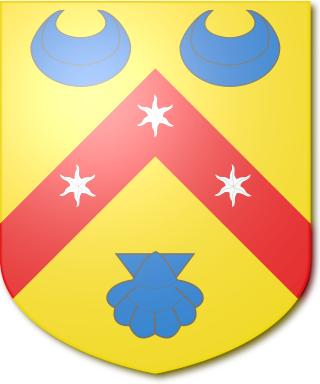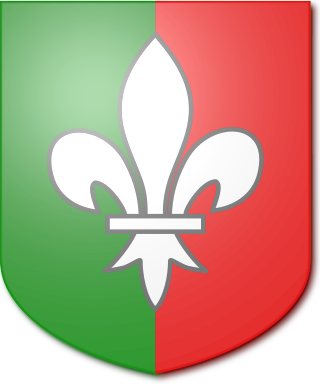
The Shaw baronetcy, of Bushy Park in the County of Dublin, was created in the Baronetage of the United Kingdom on 17 August 1821 for the Tory politician Robert Shaw. [1] [2] The 3rd Baronet was also a politician. [3]

The Shaw baronetcy, of Bushy Park in the County of Dublin, was created in the Baronetage of the United Kingdom on 17 August 1821 for the Tory politician Robert Shaw. [1] [2] The 3rd Baronet was also a politician. [3]
The heir apparent to the baronetcy is Robert Jonathan De Vere Shaw (born 1988), only son of the 8th Baronet. [7]
George Shaw (1822–1892), second son of the 3rd Baronet, was a Major-General in the British Army. [2] [8]
The Duff, later Duff Gordon Baronetcy, of Halkin in the County of Aberdeen, is a title in the Baronetage of the United Kingdom. It was created on 12 November 1813 for James Duff, British Consul in Cádiz, with remainder to his nephew, William Gordon.

The Bunbury Baronetcy, of Bunbury, Oxon and Stanney Hall in the County of Chester, is a title in the Baronetage of England. It was created on 29 June 1681 for Thomas Bunbury, Sheriff of Cheshire from 1673 to 1674 and the member of an ancient Cheshire family. His grandson, Henry, the third Baronet, and great-grandson, the fourth Baronet, both sat as Members of Parliament for Chester. The latter died unmarried at an early age and was succeeded by his younger brother, the fifth Baronet. He was a clergyman. On his death in 1764 the title passed to his eldest son, the sixth Baronet. He represented Suffolk in the House of Commons for over forty years but is best remembered for his marriage to Lady Sarah Lennox. He died childless in 1821 and was succeeded by his nephew, the seventh Baronet. He was the son of Henry Bunbury, younger son of the fifth Baronet. The seventh Baronet was a distinguished soldier and politician. His eldest son, the eighth Baronet, was High Sheriff of Suffolk in 1868, and Fellow of the Royal Society. He died childless in 1886 and was succeeded by his younger brother, the ninth Baronet. He was Liberal Member of Parliament for Bury St Edmunds. He died unmarried in 1895 and was succeeded by his nephew, the tenth Baronet. He was the son of Colonel Henry William St Pierre Bunbury, third son of the seventh Baronet. He served as High Sheriff of Suffolk in 1908 and was a Deputy Lieutenant of the county. On his death in 1930 the title passed to his son, the eleventh Baronet. He was High Sheriff of Suffolk in 1936 and was a Deputy Lieutenant of the county. His son, the twelfth Baronet, was High Sheriff of Suffolk in 1972. As of 2014 the title was held by the latter's second but eldest surviving son, the thirteenth Baronet, who succeeded in 1985.
The Adair Baronetcy, of Flixton Hall in the County of Suffolk, was a title in the Baronetage of the United Kingdom. It was created on 2 August 1838 for Robert Adair. He was succeeded by his eldest son, the second Baronet. He sat as Member of Parliament for Cambridge. In 1873 he was created Baron Waveney, of South Elmham in the County of Suffolk, in the Peerage of the United Kingdom. The barony became extinct on his death in 1886 while he was succeeded in the baronetcy by his younger brother, Hugh Adair, the third Baronet. The latter had earlier represented Ipswich in Parliament. Two of his sons, the fourth and fifth Baronets, both succeeded in the title. The fifth Baronet's son, the sixth Baronet, was a major general in the British Army. The title became extinct on the latter's death in 1988.

The Wigram Baronetcy, of Walthamstow House in the County of Essex, is a title in the Baronetage of the United Kingdom. It was created on 30 October 1805 for Robert Wigram, a successful shipbuilding merchant and politician, representing Fowey and Wexford Borough in the House of Commons. The second Baronet also represented Wexford Borough in Parliament. He assumed in 1832 by Royal licence the surname of Fitzwygram. The fourth Baronet was a Lieutenant-General in the army and sat as a Conservative Member of Parliament for South Hampshire and Fareham.

The Henniker Baronetcy, of Newton Hall in the County of Essex, was created in the Baronetage of the United Kingdom on 2 November 1813 for Brydges Henniker, who had earlier represented Kildare Borough in the last Irish Parliament. He was the youngest son of John Henniker, 1st Baron Henniker. The sixth baronet was an admiral in the Royal Navy and sat as Conservative member of parliament for Galloway. The eighth Baronet was a brigadier in the Royal Engineers.

The Currie Baronetcy is a title in the Baronetage of the United Kingdom. It was created on 11 January 1847 for Frederick Currie, Foreign Secretary to the Indian Government and a member of the Supreme Council of India. He was a grandson of William Currie (1721–1781), nephew of William Currie (1756–1829), who was Member of Parliament for Upper Gatton and Winchelsea, and the brother of Vice-Admiral Mark John Currie.

The Wedderburn, later Ogilvy-Wedderburn Baronetcy, of Balindean in the County of Perth, is a title in the Baronetage of the United Kingdom created in 1803.
The Floyd Baronetcy is a title in the Baronetage of the United Kingdom. It was created on 30 March 1816 for General John Floyd. He was second-in-command at the Battle of Seringapatam in 1799. Floyd's daughter Julia was the wife of Prime Minister Sir Robert Peel, 2nd Baronet. The fifth Baronet was a Brigadier in the 15th/19th Hussars and was Chief-of-Staff of the Eighth Army from 1944 to 1945. Between 1961 and 1968 he served as Lord-Lieutenant of Buckinghamshire. The seventh Baronet was High Sheriff of Rutland in 1968. The fourth baronet's youngest son, Charles Murray Floyd, was a prominent businessman, surveyor and land agent.

The Baronetcy of Gresley of Drakelow was created in the Baronetage of England on 29 June 1611 for George Gresley of Drakelow Hall, Derbyshire who was later High Sheriff of Derbyshire and Member of Parliament for Newcastle-under-Lyme.

The Levinge Baronetcy, of High Park in the County of Westmeath, is a title in the Baronetage of Ireland. It was created on 26 October 1704 for Richard Levinge, Speaker of the Irish House of Commons and Lord Chief Justice of the Irish Court of Common Pleas. The seventh Baronet sat as Liberal Member of Parliament for Westmeath from 1857 to 1865.

The Lighton Baronetcy, of Merville in Dublin, is a title in the Baronetage of Ireland. It was created on 1 March 1791 for the Dublin-based banker and politician Thomas Lighton. Sir Thomas was an Ulsterman, being a native of Strabane in the west of County Tyrone. After falling on hard times, he sought work as a private and interpreter in the East India Company in India. In the early 1790s he had No. 22 St. Stephen's Green North built as his Dublin residence. This house is now The Cliff Townhouse, an upmarket boutique hotel, bar and restaurant. He sat as a Member of the Irish Parliament for Tuam from 1790 to 1797 and Carlingford from 1798 to 1800. His partner in the banking firm of Lighton, Needham & Shaw, Robert Shaw, was created a baronet in 1821.

The ffolkes Baronetcy, of Hillington in the County of Norfolk, is a title in the Baronetage of Great Britain. It was created on 26 May 1774 for Martin ffolkes, FRS later High Sheriff of Norfolk and Member of Parliament for King's Lynn. The second Baronet represented Norfolk and Norfolk West in the House of Commons while the third Baronet represented King's Lynn. The fifth Baronet was Honorary Chaplain to Queen Victoria, Chaplain-in-Ordinary to Edward VII and George V and Chaplain to Edward VIII and George VI.

The Fleming, later le Fleming Baronetcy, of Rydal in the County of Westmorland, is a title in the Baronetage of England. It was created on 4 October 1705 for William Fleming, Member of Parliament for Westmorland. The second Baronet was Bishop of Carlisle. The third Baronet represented Cumberland in the British House of Commons. The fourth Baronet was Member of Parliament for Westmorland. He assumed the surname of le Fleming, an ancient version of the family surname. This version of the surname has also been borne by the Baronets from the seventh Baronet onwards. The sixth Baronet, an ordained priest, served as Rector of Windermere.
The Robinson Baronetcy, of London, was created in the Baronetage of England on 22 June 1660 for John Robinson, Lord Mayor of London and Member of Parliament for the City of London and Rye. He was the nephew of Archbishop William Laud. The fifth and sixth Baronets both represented Northampton in the House of Commons.

The Cholmeley baronetcy, of Easton in the County of Lincoln, was created in the Baronetage of the United Kingdom on 4 March 1806 for Montague Cholmeley, subsequently Member of Parliament for Grantham. His son, the second Baronet, sat as Member of Parliament for North Lincolnshire. He was succeeded by his son, the third Baronet, who also represented Grantham as MP. His grandson, the fifth Baronet, was High Sheriff of Lincolnshire in 1961 and a Vice-Lord-Lieutenant and Deputy Lieutenant of the county.

The Scott baronetcy, of Lytchet Minster in the County of Dorset, was created in the Baronetage of the United Kingdom on 8 September 1821 for Claude Scott. The title became extinct on the death of the seventh Baronet in 1961.

The Graham baronetcy, of Esk (Eske) in the County of Cumberland, was created in the Baronetage of England on 29 March 1629 for Richard Graham (c.1583–1654). He represented Carlisle in Parliament, was a Gentleman of the Horse to King Charles I and fought at the Battle of Edgehill in 1642.

The Jackson baronetcy, of Arlsey in the County of Bedford, was created in the Baronetage of the United Kingdom on 22 May 1815 for John Jackson. He was a Director of the Honourable East India Company and also represented Dover in the House of Commons.

The Dunbar baronetcy of Boath, Nairn was created on 19 September 1814 in the Baronetage of the United Kingdom for the naval captain Sir James Dunbar, knighted in 1809 or 1810.
The King Baronetcy, of Corrard in the County of Fermanagh, was created in the Baronetage of the United Kingdom on 6 November 1821 for Abraham Bradley King, an Irish businessman and local politician., who had been Lord Mayor of Dublin for 1812–13. The title became extinct on the death of the 3rd Baronet in 1921,